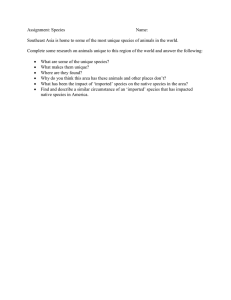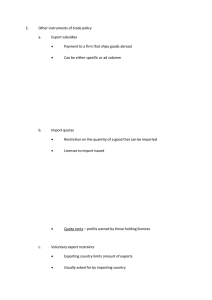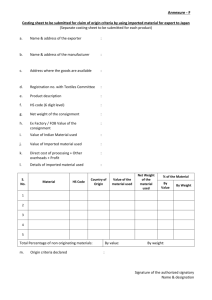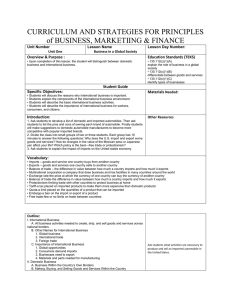Imported Machinery and Growth in LDCs
advertisement
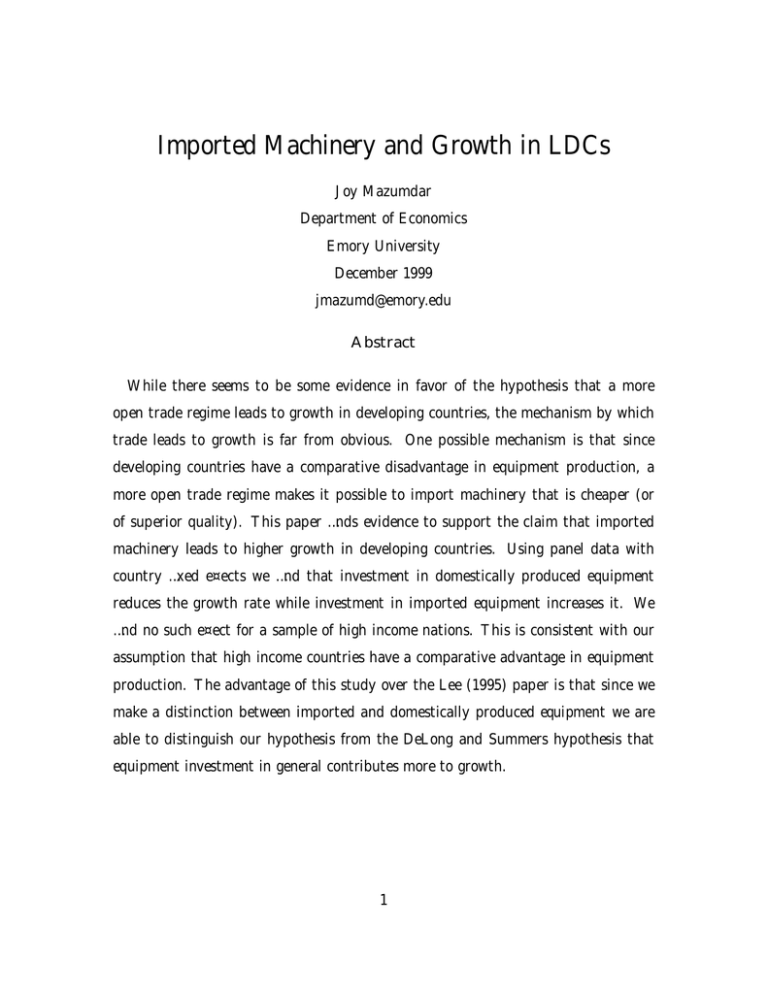
Imported Machinery and Growth in LDCs
Joy Mazumdar
Department of Economics
Emory University
December 1999
jmazumd@emory.edu
Abstract
While there seems to be some evidence in favor of the hypothesis that a more
open trade regime leads to growth in developing countries, the mechanism by which
trade leads to growth is far from obvious. One possible mechanism is that since
developing countries have a comparative disadvantage in equipment production, a
more open trade regime makes it possible to import machinery that is cheaper (or
of superior quality). This paper …nds evidence to support the claim that imported
machinery leads to higher growth in developing countries. Using panel data with
country …xed e¤ects we …nd that investment in domestically produced equipment
reduces the growth rate while investment in imported equipment increases it. We
…nd no such e¤ect for a sample of high income nations. This is consistent with our
assumption that high income countries have a comparative advantage in equipment
production. The advantage of this study over the Lee (1995) paper is that since we
make a distinction between imported and domestically produced equipment we are
able to distinguish our hypothesis from the DeLong and Summers hypothesis that
equipment investment in general contributes more to growth.
1
1. INTRODUCTION
The rapid growth of the NICs (newly industrialized countries) in the past three
decades has prompted other LDCs to liberalize their trade policies in favor of more
open trade regimes since the NICs are though to have achieved their high growth
rates at least partly by adopting a more export oriented regime. There is also some
evidence for the hypothesis that a more open trade regime leads to growth (see,
for example, Dollar 1992 and Edwards 1992). The question that still needs to be
answered is what is the mechanism by which trade leads to growth.
One possible mechanism is the import of machinery that a more outward oriented
trade regime allows. It is well known that LDCs have a comparative disadvantage
in machinery production. In 1980, imports of machinery and transport equipment
into developing countries as a whole from developed nations constituted 43% of total
developing country imports from developed countries. Whereas, exports from LDCs
of machinery and transport equipment to developed areas constituted only 4% of
total exports to developed countries. Around 85% of the imports of machinery and
transport equipment into LDCs came from developed countries.
It is possible then that more open economies grow faster because they are able to
invest in imported machinery that is cheaper (or of better quality). It might seem,
at …rst , that a way to test the hypothesis would be to see whether investment in
imported machinery yields a higher return than investment in domestic equipment.
This is the motivation behind a couple of studies in this area (Blomstrom, Lipsey,
Zejan 1992 and Romer 1993 ). They consider cross country growth regressions with a
set of explanatory variables that include both the overall investment rate and equipment imports as a fraction of gdp. Equipment imports are already included in the
investment rate. If investment in imported equipment has a higher marginal product
2
than other forms of equipment then the coe¢cient of the imported equipment variable
should be positive. Neither of these studies …nd any evidence that equipment imports
have an additional e¤ect on growth over and above the e¤ect of total investment.
A little more re‡ection shows that one might not observe any connection between
the fraction of investment in imported machinery and growth because of the following
reason. In the presence of trade barriers the domestic price of the imported equipment
will increase till the rates of return on the domestically produced and the imported
equipment are the same. However, as we will show in the theory section, in spite of
the equal rates of return from the two kinds of equipment, investment in imported
equipment will lead to a higher growth rate than investment in the domestically
produced variety. The reason for this is that the true opportunity cost of imported
equipment is lower than that of domestic equipment, although the domestic prices are
the same. The opportunity cost of imported equipment is equal to the international
price which is lower than the domestic price. Therefore, a dollar spent on imported
equipment does in fact buy more than if the dollar were spent on domestic equipment.
The di¤erence between the international price and the domestic price of imported
machinery accrues as import-quota rent (or tari¤ revenue) which is available for
investment. This quota rent is not available if the investment funds are spent on
domestic equipment1 .
One paper that …nds evidence for the hypothesis that imported machinery matters
1
This e¤ect, which involves the composition of investment, should be distinguished from the e¤ect
of a more open trade regime on the total investment rate. The availability of foreign machinery may
decrease the domestic price of machinery which in turn will increase the real investment rate (i.e.,
the amount of capital goods a given investment rate buys) and may even increase the investment
rate itself (i.e, the fraction of national income devoted to buying capital goods). In a data set that
adjusts for price di¤erences across countries (like the Penn World Tables) , both these e¤ects will
show up as a higher investment rate. The e¤ect that is being discussed in this paper is an additional
e¤ect once one controls for the overall real investment rate.
3
for growth is Lee (1995). Lee considers a cross country growth regression with several
explanatory variables that include the total investment rate and the ratio of investment in imported machinery to investment in domestically produced capital goods
(both equipment and non-equipment), the latter being the variable of interest. He
obtains his series on domestically produced capital goods by subtracting imported
machinery from the total investment series. Therefore, his domestic capital goods
includes both equipment and non equipment investment. He …nds that the ratio
of foreign machinery investment to domestic capital goods investment is positively
correlated with growth.
However, a problem with Lee’s study is that it is not possible to distinguish between his hypothesis that stresses the importance of imported equipment and that
of DeLong and Summers (1991) who emphasize the importance of overall equipment
investment (both imported and domestically produced). The major …nding of the
DeLong and Summers paper is that equipment investment has a substantially higher
e¤ect on growth than non-equipment investment. The major portion of equipment
investment in LDCs is imported. Therefore, his domestic capital goods investment
variable includes mostly non-equipment investment (his foreign machinery variable,
of course, includes only equipment). The positive coe¢cient estimate of the ratio of
foreign machinery to domestic capital goods variable in his regression may be re‡ecting the di¤erence between equipment and non-equipment investment rather than the
di¤erence between imported and domestic capital goods.
In this paper, in order to correct the problem with Lee’s study, we distinguish
between equipment investment that is domestically produced and that which is imported. We use panel data for a sample of less developed countries and use Least
Squares With Dummy Variable (LSDV) estimation. We …nd that growth is negatively
related to investment in domestically produced equipment and positively related to
investment in imported equipment.
4
The remainder of the paper is organized as follows. Section 2 provides a simple
model that is used to derive the equation to be estimated. Section 3 describes the
data and discusses various econometric issues. Section 4 presents the results. Section
5 concludes.
2. THEORY
Consider a less developed economy that has three sectors- a consumption goods
sector X and two capital goods sectors. The two capital goods sectors are a nonequipment sector Y and an equipment sector Z. The consumption goods sector and
the equipment sectors are tradeable sectors while the non-equipment sector is non
tradeable. We will assume that this economy has a comparative advantage in the
consumption goods sector and a comparative disadvantage in the equipment sector.
We will treat the consumption good as the numeraire. We will assume that all
markets are perfectly competitive and trade is balanced. We will assume that there
is no international capital mobility so that the investment of the economy has to
equal its savings.
We will assume that the production function in all three sectors is Cobb-Douglas
and that the capital-labor intensities are the same in all sectors. The production
function in all three sectors is as follows
(1¡b)®
b®
Yi = Ai L1¡®
K1i
K2i
i
(1)
for i = x; y; z
‘A’ is the productivity parameter, L is labor, K1 is non equipment capital and K2
is equipment capital. Since the capital-labor intensities are the same across sectors,
in equilibrium, the capital labor ratios will be the same in all sectors if they face the
same wage and rental rate. Therefore, the relative prices between the sectors will be
5
determined by the productivity parameter A (see Appendix 1).
The country has an import quota on equipment imports. Imported equipment is
perfectly substitutable for domestically produced equipment. The quota is binding
so that the demand for imported equipment exceeds supply. The domestic relative
price of the imported variety (the consumption good is the numeraire) will equal the
price of the domestically produced variety. The di¤erence between the free trade
price of equipment and the domestic price is the quota rent accruing to whoever is
lucky enough to get the quota licenses. We assume that these licenses are allocated
to domestic citizens.
Per capita national income y at domestic prices in the absence of trade is given by
the following expression
y = x + py y + pz z
(2)
Here, x; y and z are the per capita quantities produced of the three goods and py
and pz are the domestic relative prices of goods y and z.
When there is trade and some amount of the z good (equipment) is imported then
we have an additional term in the expression. This additional term arises from the
fact that some amount of the x good is exported and some amount of equipment is
imported. If im
2 is the per capita quantity of equipment that is imported then the
amount of x that has to be exported in order to pay for the import (since trade is
¤
balanced) is p¤z im
2 , where pz is the world price of the z good. Therefore, this term
has to be subtracted from x in the expression above. In exchange, the amount im
2 is
imported which at domestic prices is valued at pz im
2 . This term has to be added to
the expression above. Therefore, when there is trade the expression above changes
to the following
y = x + py y + pz z + (pz ¡ p¤z )im
2
(3)
The fourth term on the right hand side of the equation above represents the quota
rents since it is the di¤erence between what producers pay for the equipment and
6
what they sell it at in the country. If the domestic and the world prices of equipment
are the same then this term is equal to 0. However, when the domestic price is greater
than the world price quota rents are positive.
At domestic prices the per capita national income of the country in terms of the
numeraire can be expressed as follows
y = Ax k1b® k2(1¡b)® + (pz ¡ p¤z )im
2
(4)
where, k1 and k2 are per capita non-equipment and equipment capital, respectively.
pz and p¤z are the domestic and world prices of equipment. im
2 is the quantity of per
capita equipment imports. The …rst term is the value of total production in the
country in terms of the numeraire valued at domestic prices. It is equal to the sum
of the …rst three terms on the right hand side of equation (3) (see Appendix, A.1).
The second term is the additional income in the form of quota rents.
A diagrammatic representation of quota rents and national income in terms of the
production possibility frontier (ppf) is shown on Figure 1 (where we have only two
goods, for simplicity). The line DD0 is the ppf. The slope of this line (absolute value)
is equal to the domestic relative price of equipment (in terms of the consumption
good). The country produces the bundle represented by P . The line T T 0 is the
budget line of the country when national income is valued at world prices. The slope
of the line is equal to the world price of equipment. The world price of equipment
is lower than the domestic price. If it trades with the rest of the world then it has
to operate on T T 0 . The country consumes the bundle C. That is, it exports some
consumption goods in exchange for equipment. The value of this consumption at
domestic prices has to equal the value of its income at domestic prices. The budget
line representing this level of income is QQ0 . The distance QD is the quota rent.
National income comes from four sectors - the three goods as well as a trading sector
that exports some of the consumption goods and imports equipment at world prices
7
but sells it in the economy at higher domestic prices. The quota rent represents the
gains from trade (as shown on the graph).
We will assume that the savings rates are exogenous. Let the savings rates (at
domestic prices) in the two kinds of capital - equipment and non-equipment be s1
and s2 , respectively. We will assume that the quota is equal to a constant fraction
‘q’ of i2 or total per capita equipment investment. Then the savings rate in imported
equipment, sm
2 , is equal to qs2 . We will assume that non-equipment capital depreciates
at the rate ±1 , and all equipment capital depreciates at the rate ± 2. Our assumptions
imply
im
2 = qi2 =
qs2 y
pz
(5)
Therefore, using equations (4) and (5), we have
(1¡b)®
Ax k1b® k2
y=
¤
[1 ¡ (pz ¡ppzz )qs2 ]
(6)
The equations of motion of the two kinds of capital are
si y
¡ ± i ki
k_ i =
pi
(7)
si y S = pi ±i kiS
(8)
for i = y(or1); z(or2).
In the steady state we will have
for i = y(or1); z(or2).
Using equations (6) and (8) and taking logs we get an expression for the log of the
steady state y which is as follows
Ã
!
Ã
!
"
1
b®
s1
(1 ¡ b)®
s2
1
(pz ¡ p¤z )qs2
log y =
log Ax +
log
+
log
¡
log 1 ¡
1¡®
1¡®
py ± 1
1¡®
pz ± 2
1¡®
pz
(9)
S
8
#
The last term, related to quota rents, captures the level of e¢ciency of this economy.
The greater is the amount of imports, the higher are the quota rents. The quota rents
represent the gains in income that come about as a result of trade. In this economy
with no money and balanced trade, quota rents arise because the traders export
the consumption good in exchange for imported equipment. The producers of the
consumption good are paid in terms of the investment goods at prevailing domestic
prices which is lower than world prices. The di¤erence between what producers of
the consumption good get and what the traders have obtained on the world market
is the quota rent. This also is equal to the gains from trade because it is equal to the
di¤erence between the world price and the domestic rate of transformation (which is
equal to the domestic price). Therefore, higher is the level of the quota, the greater
will be the level of income in this country.
Equation (9) gives an expression for steady state capital stock when income and
savings rates are being measured at domestic prices. The Penn World data set computes these variables at international prices. Since we are going to use this data set
in our regressions, it will be useful to …nd an expression for the steady state y when
all variables are measured in terms of international prices. This expression is given
below.
log y ¤S
(
"
s¤
s¤
(pz ¡ p¤z )(1 ¡ q)s¤2
1
log Ax + b® log ¤ 1 + (1 ¡ b)® log ¤ 2 ¡ log 1 +
=
1¡®
py ± 1
pz ± 2
p¤z
(10)
The asterisk denotes that the variables are being measured at world prices. The
expression looks very similar to the previous one except that the savings rates are now
measured in international prices and the prices are international prices. Also, the last
term has been altered. The expression (1 ¡ q)s¤2 is the investment rate in domestic
equipment valued at international prices. Production of domestic equipment reduces
income at world prices since production of consumption goods is reduced to produce
domestic equipment at a rate that is higher than the world price of equipment. The
9
#)
greater is the production of domestic equipment, lower is income at world prices.
This is the counterpart to the quota rents when income is valued at world prices than
at domestic prices. The economy is more e¢cient is the sense of making more goods
available when it is producing closer to its comparative advantage. Figure 1 shows a
comparison of the two methods of measuring national income (at domestic prices vs.
at world prices) in terms of the ppf. As was mentioned before, QQ0 represents income
at domestic prices while T T 0 represents income at world prices. As one can see on the
graph, the di¤erence between the domestic price and the world price leads to both the
quota rents (when income is being measured at domestic prices) and the income loss
due to lower e¢ciency (when income is being measured at world prices). The segment
DT represents the e¢ciency loss resulting from the production of equipment, when
income is measured at world prices. The expression for per capita national income
when valued at world prices as well as the derivation of equation (10) are in Appendix
1 (A.2).
Using the expression for the steady state income in equation (10), we can derive an
expression for the growth rate (see Barro and Sala-i-Martin 1995), when all variables
are measured at world prices. It is as follows:
"
#
(1 ¡ b)®
1
(pz ¡ p¤z )(1 ¡ q)s¤2
b®
y¤
C log s¤1+
C log s¤2¡
C log 1 +
¡C log y0¤
log t¤ = K1 +
y0
1¡®
1¡®
1¡®
p¤z
(11)
In the equation above y0¤ is initial income, K1 is a collection of constants and
C = (1 ¡ e¡¯t).
Taking a …rst order Taylor approximation of the fourth term in the equation (11)
around (1 ¡ q) equal to 0 , we get,
log
yt¤
b®
(1 ¡ b)®
1
(pz ¡ p¤z ) ¤
¤
¤
=
K
+
C
log
s
+
C
log
s
¡
C
s2 (1 ¡ q) ¡ C log y0¤
2
1
2
y0¤
1¡®
1¡®
1¡®
p¤z
(12)
Equation (12) is the equation to be estimated. The exogenous variable of interest is
10
s¤2(1¡q) which is the fraction of income (at international prices) spent on domestically
produced equipment or the investment rate in domestically produced equipment. If
the domestic price of equipment is higher then the coe¢cient on s¤2 (1 ¡ q) should be
negative and a higher s¤2 (1¡q) will lead to lower growth. A lower s¤2 (1¡q) acts like an
improvement in the country’s level of technology. An improvement in the technology
increases income directly but it has an increase in the growth rate because a higher
capital stock can be sustained in the steady state. The basic intuition behind why a
reduction in the production of domestic equipment or an increase in the investment
rate in imported equipment will increase growth rates is the following. It acts like
an increase in the level of technology. This by itself would not increase the growth
rate. It would increase the level of income in all time periods without raising the
growth rate. The increase in the growth rate come about because of increased capital
accumulation. Capital accumulation results from the di¤erence between the capital
goods bought with the savings and that required to replenish the depreciated capital
stock. Therefore, higher is the level of income, larger will be savings and therefore
capital accumulation and growth.
3. DATA AND ESTIMATION ISSUES
Data
The data on gdp, investment and other macroeconomic variables were obtained
from the Penn World Table 5.6 compiled by Summers and Heston (see Summers and
Heston 1991, and Kravis, Kenessey, Heston and Summers 1975 for details) . This data
set also contains investment data at a disaggregated level on the …ve components of
investment - machinery, transportation equipment, business construction, residential construction and other construction. The data on machinery constitutes my
equipment data. The Summers and Heston data set also provides data on aggregate
11
investment as mentioned before. Due to di¤erences in the method of computation,
the disaggregated series do not add up to the aggregate series.
The data on gross domestic product and the disaggregated investment series are
in 1985 international prices which makes the data comparable across countries. International prices are, roughly speaking, weighted averages of the price levels of the
countries of the world. The weights are proportional to the gdp of the di¤erent countries. Therefore, the international price level is close to the price levels prevailing in
the rich countries of the world. The average price level of GDP of my high income
sample was around 112 (international price level = 100) while the average price level
of investment was 99. On the other hand, the average price level of GDP of my LDC
sample was around 53 while the average price level of investment was 72.
The data on imported machinery were obtained from OECD International Trade by
Commodities Statistics. It contains data on machinery exports of OECD countries to
all other countries. Since almost all of machinery imports of less developed countries
comes from the high income nations which belong to the OECD, the data on total
machinery exports of all OECD countries to a less developed country will be a good
measure of the country’s machinery imports. The data is appropriate for the issue
we are really interested in and that is whether or not developing countries bene…t
from machinery imports from developed nations since they embody technology, are
of higher quality etc. The data are in current U.S. dollars. We assume that the data
on imported machinery are at current international prices since the price level of the
machinery imports will be close to the price level of the rich nations and therefore to
the international price level.
The fraction s¤2 (1 ¡ q) or the proportion of income spent on domestically produced
equipment is obtained by taking the di¤erence between the ratio of real equipment
investment to real gdp (real values are at 1985 international prices) and the ratio of
imported machinery to gdp at current (international) prices. For my LDC sample,
12
we selected all less developed countries for which data on both equipment investment
and imported machinery were available for most years in the sample period2 . My
sample period is 1970-1990. We chose this period because data were missing for
quite a few years for many LDCs before and after this period. The high income
sample includes all countries that are classi…ed as high income countries by the World
Development Report except the oil producing countries and countries are considered
to be developing if they are classi…ed as such by the United Nations or by their own
governments.
Estimation
One problem with applying OLS to equation (12) is the constant term may di¤er
across countries. The constant term includes the productivity parameter which is very
likely to di¤er across countries. It may capture the e¤ects of di¤erences in technology,
institutions, resource endowments (see Islam 1995). Also, it will be correlated with
the regressors which include the investment rate. A better technology will increase
the rate of return from investment and therefore increase the investment rate. If we
impose the restriction that the constant term is the same across countries then there
will be an omitted variable bias which will lead to biased and inconsistent estimators.
Another problem associated with this data may be measurement error. The investment rate in domestically produced equipment turns out to be negative for a few
countries. This may be due to mismeasurement of equipment investment for some
countries. It is less likely that the import data is mismeasured since it is based on
customs data which is more reliable. If one makes the assumption that for any given
country the extent of mismeasurement is the same in all periods then it can be subsumed under the constant term which is di¤erent across countries but the same for
2
A few countries had to be dropped because their investment rates in domestic equipment were
negative which is most probably due to measurment error.
13
all periods for any given country3 .
. The country speci…c term will be correlated with the regressors because it includes
the productivity term, as mentioned before and also because of the measurement
error. Therefore, one should use a …xed e¤ects model and estimate equation (12)
using Least Squares with Dummy Variables (LSDV).
4. RESULTS
LDC Sample
Before discussing the regression results it is useful to check whether some of the
other implications of the theory hold. According to the theory quota restrictions
increase investment in domestic equipment which in turn reduces the growth rate
due to ine¢ciencies in the allocation of resources. Therefore, there should be a
positive relationship between the extent of quota restrictions and the investment rate
in domestic equipment. An absence of any relationship between the two would suggest
something else was going on, even if growth rate was found to be negatively related
to the investment rate in domestic equipment. Unfortunately, time series data on non
tari¤ barriers is not available. However cross section data on non tari¤ barriers (NTB)
on intermediate and capital goods is available in the Barro and Lee data set. Table
1 provides the results of OLS regression of investment rate in domestic equipment on
the Barro-Lee non tari¤ barrier measure. The non tari¤ barrier measure turns out
to be positive and strongly signi…cant. The investment rate in domestic equipment
would of course depend on other factors like the overall investment rate. Inclusion
of the overall investment rate in the same regression reduces the estimate of the
3
The few countries that have negative domestic equipment investment rates have negative rates,
which do not vary much, for all the periods under consideration suggesting that the extent of
mismeasurment stays more or less the same across time.
14
coe¢cient of the quota measure dramatically but it continues to be signi…cant at the
5% level.
Table 2 reports the results of the regressions using equation 12 with the investment
rate in domestic equipment as the independent variable of interest. We use panel
data with country and time dummies. In regression 1 we have equipment investment
rate, non equipment investment, initial income and the investment rate in domestic
equipment as independent variables. The coe¢cient estimate of the domestic equipment investment rate is negative as the theory would predict4 . It is also signi…cant at
the 5% level. The estimate is very high. It implies that an increase in the investment
rate in domestic equipment by 1 percentage point decreases growth rate by almost
1.2 percentage points. The estimates imply that domestic equipment is about 17
times more expensive than imported equipment5 . Note that the coe¢cient for the
equipment investment variable is positive and signi…cant while the coe¢cient for the
non equipment investment variable is small and insigni…cant. This is consistent with
the DeLong and Summers result.
An obvious omitted variable that may be correlated with the variable of interest in
this paper is some measure of openness. A higher degree of trade may lead to higher
growth simply because of other reasons (e.g., new ideas resulting from interaction with
other countries etc.) The second column reports the results of the regression with
the trade share as an additional right hand side variable. The domestic equipment
rate continues to be signi…cant and the trade share is insigni…cant. It is interesting
to compare the results of this regression with one which has the trade share as an
4
These results are not sensitive to the inclusion of Botswana. The discovery of diamonds in Bost-
wana led to large equipment investment which tends to bias the coe¢cient of equipment investment
upwards (see DeLong and Summers 1991).
5
This estimate is obtained by dividing the estimated coe¢cient of the domestic equipment variable
by the sum of the coe¢cients of the log of equipment and log of non equipment investment variables
and adding 1 (see equation 12).
15
independent variable but does not have the domestic equipment rate on the right
hand side. Regression 3 in the fourth column reports the results of this regression.
The trade share is positively and signi…cantly related to growth. Since the inclusion
of the domestic equipment rate makes the trade share variable insigni…cant (Reg 2),
this suggests that the positive relationship between growth and openness (captured
by the trade share) is mainly because of equipment imports. This, in our opinion,
gives us a better understanding of how openness can a¤ect the growth processes of
developing countries.
Another reason why there may be a spurious correlation between growth and the
domestic equipment rate is because of balance of payments constraints. If an economy
is not performing well, it is likely that it will run into balance of payments di¢culties
as a result of which it may not be able to import goods including equipment. In
the regression 4 in this table we have included two measures that will re‡ect balance
of payments constraints - the average exchange rate and the balance of payments
premium (the di¤erence between the o¢cial exchange rate and the market exchange
rate; this data is also obtained from the Barro-Lee data set). This regression also
includes the trade share as well as the import share (in case imports have a greater
e¤ect on growth than trade in general). The domestic equipment rate continues to
be signi…cant although the size of the coe¢cient decreases somewhat. In regression
5, we also included the share of direct foreign investment in GDP as an additional
control variable. It is possible that direct foreign investment may be correlated with
machinery imports and growth may increase due to the transfer of (disembodied)
technical know how resulting from the foreign investment and not because of machinery imports per se. The domestic equipment rate continues to be negatively and
signi…cantly related to growth (although at the 10% level). Since the …rst …ve regressions do not directly test the hypothesis that imported equipment is superior, we have
included the investment rate in imported equipment instead of the investment rate in
16
domestic equipment in the last regression in this table. As expected, the coe¢cient
of the imported equipment variable is positive and signi…cant.
High Income Sample
The theory predicts that we should observe this result for less developed countries
but not for developed nations since the latter have a comparative advantage in equipment. Table 3 reports the results of the regression for a sample of developed nations.
The …rst column includes all the countries in the high income sample. In the …rst
regression while the domestic equipment variable is not signi…cant at the 5% level
it is signi…cant around the 10% level. In the second regression we include the trade
share and the domestic equipment variable becomes signi…cant at the 5% level and
the coe¢cient is negative. This appears to cast some doubt on the theory. However,
one can question the assumption that all the countries in the sample have a comparative advantage in equipment production. In particular, the assumption that Ireland
has a comparative advantage in equipment production is probably false. Ireland was
one of the poorest of the high income nations during this period. Therefore, one
should check how sensitive these results are to the inclusion of Ireland. The third
column reports the results of the regression without Ireland. One can see that there
is a dramatic decrease in the absolute value of the estimate for domestic equipment
investment. The absolute value drops from 0.42 to 0.28. The t-statistic also drops
substantially and the variable is no longer signi…cant. The estimates of the other
investment variables also decrease but only very little and the t-statistics are not
a¤ected much. This is also what one would expect since the other investment variables should a¤ect growth positively regardless of whether the country is developed
or underdeveloped.
One could criticize the results for both the LDC sample as well as the sample
with high income countries on the grounds that these right hand side variables are
17
endogenous. Productivity di¤erences across countries that may lead to a spurious
correlation will be captured by the …xed e¤ects and therefore will not lead to a bias in
our estimates. However, productivity shocks within a country over di¤erent time periods may lead to as spurious correlation between growth and the domestic equipment
rate. Instrumental variable estimation would solve that problem. Valid instruments
for the domestic equipment rate would be measures of trade barriers especially nontari¤ barriers. Unfortunately, time series data on non-tari¤ barriers for a large enough
sample of countries does not exist making IV estimation impossible. However, the
other control variables in the regression like the balance of payments premium would
capture some the e¤ects of these productivity shocks. Also, it is di¢cult to imagine
how reverse causality would lead to a negative relationship between growth and the
domestic equipment rate.
5. CONCLUSION
There seems to be evidence to support he claim that investment in domestic equipment reduces the growth rate for less developed countries. This is because it leads to a
misallocation of resources (since LDCs have a comparative disadvantage in equipment
production) which acts like a decrease in the level of technology. This reduces real
income and therefore real investment (for any given savings rate) and growth. Also,
the evidence suggests that openness a¤ects growth mainly through equipment imports. For a sample of rich nations, there seems to be no evidence that investment in
domestically produced equipment a¤ects growth adversely. This is just as one would
expect since developed countries have a comparative advantage in the production of
equipment.
18
APPENDIX
A.1 Derivation of the …rst term in equation (4)
Using the fact that the marginal revenue product of labor has to be the same in
all sectors, we get,
0(1¡b)®
0b®
Ax k1x
k2x
0(1¡b)®
0b®
= py Ay k1y
k2y
0(1¡b)®
0b®
= pz Az k1z
k2z
(13)
0
0
and k2i
(i = x; y; andz) denote the capital stock per worker in that industry
Here k1i
and not per person in the economy. Using the fact the marginal revenue product of
the two kinds of capital (equipment and non-equipment) will have to be the same
across sectors, we get
0(1¡b)®
0(1¡b)®
(14)
0b® 0(1¡b)®¡1
0b®¡1 0(1¡b)®
0b® 0(1¡b)®¡1
Ax k1x
k2x
= py Ay k1y
k2y
= pz Az k1z
k2z
(15)
0b®¡1
Ax k1x
k2x
0(1¡b)®
0b®¡1
= py Ay k1y
k2y
0b®¡1
= pz Az k1z
k2z
and,
Dividing (13) by (14), we get,
0
0
0
k1x
= k1y
= k1z
(16)
0
0
0
k2x
= k2y
= k2z
(17)
Dividing (13) by (15), we get,
Using the information given by equations (16), (17) in equation (13), we get,
Ax = py Ay = pz Az
(18)
As one can see from equation (18), the domestic relative prices of the goods are
determined by the level of technology in the three industries.
19
The gross domestic product (ignoring the trading sector) will equal the value of
total output in terms of the numeraire and is given by the following expression
0(1¡b)®
0b®
Y = Ax k1x
k2x
0(1¡b)®
0b®
Lx + py Ay k1y
k2y
0(1¡b)®
0b®
Ly + pz Az k1z
k2z
Lz
(19)
where Lx, Ly , Lz denote the workers employed in the three industries.
Using (16), (17), (18) and (19), we get,
0b® 0(1¡b)®
Y = Ax k1x
k2x
L
(20)
where L = Lx + Ly + Lz , is the total population of the economy. Since the capital
0
0
labor ratios are the same in all industries k1x
and k2x
will equal k1 and k2 , respectively.
That is, the capital per worker ratio in each industry will equal the overall capital
per worker for the economy as a whole. Dividing both sides of (20) by L , we get,
y = Ax k1b® k2(1¡b)®
(21)
A.2 Derivation of equation (10)
When all variables are measured at world prices then the per capita gdp is given
by the following expression
(1¡b)®
y ¤ = Ax k1b® k2
¡ (pz ¡ p¤z )id2
(22)
where id2 is the quantity of domestic equipment produced. Since the country has a
comparative disadvantage in equipment, production of equipment reduces income at
world prices (as shown on graph 2 and explained in section 2).
Now from equation (5) we get,
id2 =
s2 y(1 ¡ q)
pz
20
(23)
where y is per capital national income at domestic prices and s2 is the investment
rate in equipment at domestic prices.
Using equations (6), (22) and (23) we get,
y¤ =
Ax k1b® k2(1¡b)®
Or, using equations (6) and (24),
2
4
1¡
1¡
(pz ¡p¤z )s2
pz
(pz ¡p¤z )qs2
pz
3
5
y
1
=
¤ )s
(p
¤
z 2
y
1 ¡ z ¡p
pz
Now,
s¤1 =
(24)
(25)
p¤y i1
py i1
s1y
=
=
y¤
y¤
y¤
(26)
Here we have made the assumption that the domestic and world relative price of
non-equipment are the same.
Also,
s¤2 =
p¤2 i2
p¤2 s2 y
y p¤2
=
=
s
2
y¤
y ¤ p2
y ¤ p2
(27)
Using equations (25), (26) and (27), we get the following three relationships
y=y
¤
"
(pz ¡ p¤z )s¤2
1+
p¤z
#
(28)
and,
s1 =
and,
s2 =
s¤1
1+
(pz ¡p¤z )s¤2
p¤z
pz
s¤2
¤ ¤
p¤z 1 + (pz ¡p¤z )s2
(29)
(30)
pz
Substituting y, s1and s2 in equation (9) for the expressions in the three equations
given above we get equation (10).
21
LIST OF COUNTRIES
LDC Sample
Argentina
Botswana
Colombia
Dominican Republic
Greece
Guatemala
Honduras
Hong Kong
India
Israel
Jamaica
Kenya
Korea (South)
Malawi
Mauritius
Mexico
Nepal
Panama
Paraguay
Peru
Philippines
Poland
Sri Lanka
Swaziland
22
Taiwan
Thailand
Turkey
Venezuela
Yugoslavia
Zimbabwe
High Income Sample
Australia
Austria
Belgium
Canada
Denmark
Finland
France
Germany (West)
Iceland
Ireland
Italy
Japan
Netherlands
New Zealand
Norway
Spain
Sweden
Switzerland
United Kingdom
23
United States
24
REFERENCES
[1] Baldwin, Richard, “Measurable Dynamic Gains from Trade.” Journal of Political
Economy 100 (February 1992): 162-74.
[2] Barro, Robert and Sala-i-Martin, Xavier, Economic Growth, McGraw-Hill, Inc., 1995.
[3] Blomstrom, M., Lipsey, R. and Zejan, M., “What Explains Developing Country
Growth?,” NBER working paper # 4132, (August 1992).
[4] DeLong, B. and Summers, L., “Equipment Investment and Economic Growth.” Quarterly Journal of Economics 106 (May 1991): 445-99.
[5] Dollar, D., “Outward-Oriented Developing Economies Really Do Grow More Rapidly:
Evidence form 95 LDCs 1976-1985.” Economic Development and Cultural
Change 40 (April 1992): 523-44.
[6] Edwards, S., “Trade Orientation, Distortions and Growth in Developing Countries.”
Journal of Development Economics 39 (july 1992): 31-58.
[7] Islam, N., “Growth Empirics: A Panel Data Approach,” Quarterly Journal of Economics 110 (November 1995): 91-110
[8] Kravis, I., Kenessey, Z., Heston, A. and Summers, R., A System of International Comparisons of Gross Domestic Product and Purchasing Power, The Johns Hopkins
Press, 1975.
[9] Lee, Jong-Wha, “Capital Goods Imports and Long Run Growth,” Journal of Development Economics 48 (October 1995): 91-110.
25
[10] Romer, P., “Idea Gaps and Object Gaps in Economic Development.” (paper given
at the World Bank Conference, ”How Do National Policies A¤ect Long Term
Growth?”) 1993
[11] Summers, R. and Heston, A., “The Penn World Table (Mark 5): An Expanded Set of
International Comparisons, 1950-88.” Quarterly Journal of Economics 106 (May
1991): 327-68.
26
TABLE 1 (24 LDCs)
Dep var: average investment rate in domestic equipment (1965-1990)
Reg 1
non tari¤ measure
Reg 2
0.47** 0.014**
(0.12)
overall investment rate
(0.006)
0.075*
(0.039)
Standard errors are in parentheses; ** denotes that the variable is signi…cant at the 5% level. *
denotes varaible is signi…cant at the 10% level.
27
TABLE 2 (30 LDCs)
Dep var: 5 yr avg. growth rate
(includes country and time dummies)
log of equipment investment rate
Reg 1
Reg 2
Reg 3
0.07**
0.067
0.035
(0.018)
(0.018)
(0.012)
-.0008
0.003
(0.012)
(0.012)
log of non-equipment investment rate 0.004
(0.012)
domestic equipment investment rate
-1.19** -1.03**
(0.42)
(0.43)
imported equipment investment rate
log of initial income
-0.07** -0.079** -0.09**
(0.02)
trade share
(0.02)
(0.015)
0.0005
0.0009**
(0.0003)
(0.0003)
0.73
0.67
import share
exchange rate
balance of payments premium
direct foreign investment share
R2 (adjusted)
0.72
Standard errors are in parentheses; ** denotes that the variable is signi…cant at the 5% level. *
denotes that the variable is signi…cant at the 10% level.
28
TABLE 2 (continued)
Dep var: 5 yr avg. growth rate
(includes country and time dummies)
log of equipment investment rate
Reg 4
Reg 51
Reg 6
0.06**
0.067**
0.026
(0.02)
(0.021)
(0.012)
-0.005
0.005
(0.018)
(0.019)
(0.011)
-0.92**
-1.02*
(0.45)
(0.54)
log of non-equipment investment rate -0.015
domestic equipment investment rate
imported equipment investment rate
1.7**
(0.57)
log of initial income
trade share
import share
exchange rate
balance of payments premium
-0.09**
-0.085**
-0.06**
(0.02)
(0.025)
(0.018)
0.002
0.001
(0.0017)
(0.0018)
-0.004
-0.001
(0.004)
(0.0036)
-0.000015
-0.00001
(0.00001)
(0.000018)
-0.00003
-0.00012
(0.000075) (0.000011)
direct foreign investment share
0.236
(0.24)
R2 (adjusted)
0.72
0.72
0.72
Standard errors are in parentheses; ** denotes that the variable is signi…cant at the 5% level. *
denotes that the variable is signi…cant at the 10% level. 1 Excludes Hong Kong and Poland.
29
TABLE 3 (20 High Income Nations)
Dep var: 5 yr avg. growth rate
(includes country and time dummies)
log equip. inv.
log non-equip inv.
domestic equip inv.
log initial income
Reg 1
Reg 2
Reg 31
0.017
0.018
0.018
(0.015)
(0.016)
(0.016)
-0.002
-0.003
0.003
(0.017)
(0.017)
(0.017)
-0.316*
-0.42**
-0.28
(0.189)
(0.20)
(0.24)
-0.102**
-0.11**
-0.114**
(0.02)
(0.02)
(0.02)
-0.0003
-0.0003
trade share
(0.0002) (0.0002)
R2 (adjusted)
0.88
0.88
0.88
Standard errors are in parentheses; ** denotes that the variable is signi…cant at the 5% level. *
denotes that the variable is signi…cant at the 10% level. 1 Excludes Ireland
30
Q
quota rents
efficiency loss
{
{D
T
.
.
P
C
D’
O
Q’
T’
Equipment
Fig. 1.
31
